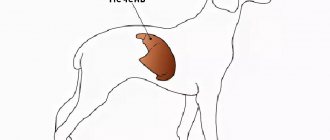What is liver fibrosis and cirrhosis in dogs?
First of all, you need to know that the scary word “cirrhosis” actually means a condition that does not occur spontaneously and suddenly. We are talking about the final stage of development of severe liver failure, or, as it is also called, hepatopathy.
Dogs, like people, encounter various forms of liver disorders quite often, and the danger of this type of disease is complex diagnosis, even more difficult treatment and very frequent relapses. Moreover, medicine still does not have a full range of knowledge regarding the mechanisms of development of liver failure. It is reliably known that this process can be acute and chronic, inflammatory and non-inflammatory, but at the same time it is somehow accompanied by a critical decrease in one or more liver functions, as a result of which this vital organ loses its ability to ensure the normal functioning of the body as a whole.
Important! The word “hepatopathy” is of ancient Greek origin (“ἡπατῖτις” - liver, “πάθος” - disease, suffering) and is an outdated name for any diseases of this organ.
The uniqueness of the liver compared to other organs and systems lies in its ability to use compensatory mechanisms for a long time to replace lost functions, and therefore, even in the presence of serious morphological changes in the gland, it is not always possible to clearly determine the clinical signs of hepatopathy in an animal. For the same reason, veterinarians are well aware that the concept of “liver failure” always sounds vague and vague, and conditions such as cirrhosis, fibrosis, hepatitis or hepatosis, although they are forms or complications of hepatopathy, at the same time cannot be considered absolute synonyms this generalized name for pathology.
Depending on what pathogenetic mechanisms triggered liver failure, the disease can proceed differently, but in most cases, in the process of its development, massive oxidative free radical damage occurs to the structure of the epithelial cells of the organ - the parenchyma.
These functionally active cells (and in a dog they can account for 60–80% of the total mass of the liver) play a critical role in performing the main tasks of the gland, namely:
- production of bile and bile salts;
- storage of protein compounds;
- synthesis of phospholipids and cholesterol;
- carbohydrate processing;
- neutralization and removal of toxins and breakdown products from the body.
That is why, as liver failure develops in the animal’s body, the main metabolic processes are disrupted, the protective ability is reduced, cholestasis, hypokalemia, encephalopathy can develop, and subsequently more severe complications, including cirrhosis.
Important! Cirrhosis is a progressive condition in which pathological growth of the connective tissue of the liver occurs, a critical decrease in the number of working cells, the formation of scars, and as a result, a complete change in the structure and architectonics of the organ.
In the final stages of cirrhosis, heavy and pathogenic connective tissue, which has a nodular structure, completely replaces healthy liver lobules.
Approximately the same changes in the organ occur during fibrosis, but in this case the structure of the liver remains unchanged, and therefore the disease is considered reversible. However, if help is not provided to the pet on time, fibrosis will eventually transform into cirrhosis.
Speaking about complex forms of hepatopathy, we should mention such special types of pathology as cardiac cirrhosis and cardiac fibrosis. Both of them develop against the background of heart failure and are associated with the systemic relationship of all organs with each other. Thus, if the heart does not work properly, a chain reaction occurs, which is reflected, in particular, on the functioning of the liver: from the overflow of blood in the central hepatic lobules, the vessels gradually stretch, active epithelial cells die, are overgrown first with fibrous and then scar tissue, the structure of hepatocytes undergoes irreversible changes , the outflow of bile is blocked, coma and death occur.
Did you know? According to statistics, cirrhosis is diagnosed in men three times more often than in women. And although this dangerous disease is not always a consequence of alcoholism, doctors explain this gender selectivity precisely by the greater tendency of the stronger sex to drink strong drinks.
Another specific form of hepatopathy that can occur due to heart problems is the so-called hepatic shunt. It is this condition that is sometimes not quite correctly called hepatic cardiac fibrosis. We are talking about an abnormal change in the branches of the portal vein, in which a certain part of them, instead of passing through the liver, bypasses this vital organ. Since in a normally functioning body it is in the liver that the neutralization of harmful substances that somehow end up in the stomach, spleen, pancreas, intestines and other internal organs occurs, all these toxins, along with the bloodstream, must necessarily enter the main filtration center, which is done through the branches portal vein. Thus, a hepatic shunt (an alternative name is anastomosis) leads to the fact that the detoxification function of the liver simply cannot be realized.
Why do they appear?
The idea that the direct and immediate cause of cirrhosis is alcohol abuse has long been firmly established in the minds of many people. But if for a person such an explanation of severe liver damage can be considered logical, then this approach is definitely not applicable to a dog, and therefore, in general, should be considered not entirely correct. Indeed, there are a huge number of factors that can trigger hepatopathy, and, most likely, not all of them are known to modern science.
The most common “internal” cause of the development of fibrosis and cirrhosis of the liver in dogs are diseases of the organ such as hepatitis, hepatosis, congenital pathologies of the development of liver cells, bile stagnation, infectious processes (for example, echinococcosis), as well as dysfunction of the gallbladder and biliary tract.
Important! Numerous causes of the development of cirrhosis, fibrosis and other liver diseases are usually divided into two large categories - hepatic and extrahepatic. The first are directly related to problems that arise within the organ itself, while others, such as the aforementioned cardiac fibrosis, affect the liver as a consequence of pathology developing in other parts of the body.
As for systemic diseases, the trigger for the development of liver failure can be, for example:
- diabetes;
- obesity;
- disruption of the endocrine system;
- hormonal imbalance (especially excess estrogen);
- vitamin deficiency (deficiency of vitamin E, pyridoxine, cobalamin, etc.);
- hemochromatosis (excessive absorption of iron);
- heart or kidney failure;
- rheumatoid arthritis;
- cholecystitis;
- pancreatitis;
- biliary obstruction;
- chronic enterocolitis and many others. etc.
A separate category of causes leading to liver damage in dogs are various types of poisoning, i.e. direct effects of hepatotoxins on the organ. The range of such substances is very wide. These include, in particular:
- plant poisons (including mushroom poisons);
- household chemicals (paints, solvents, acids, antifreeze, formaldehydes, etc.);
- medications (corticosteroids, diuretics, antibiotics, especially tetracyclines and macrolides, medications for worms and ticks).
Other unfavorable factors that can trigger pathological processes in the liver include, for example, severe emotional stress, chronic fatigue, etc.
Did you know? Foie gras is a delicious French appetizer made from the liver of a specially fattened goose. Interestingly, the weight of one such liver, due to immobilization and force-feeding of high-calorie food, can reach 600 g, which is about 10 times the normal size of the same internal organ in a healthy bird.
In addition, you need to know that a number of dog breeds have a genetic predisposition to hepatopathy; moreover, the disease in such animals is especially severe and very often leads to fibrosis and cirrhosis. The risk group, in particular, includes:
- German Shepherds;
- cocker spaniels;
- Tibetan spaniels;
- Labradors;
- retrievers;
- Dobermans;
- poodles;
- Rottweilers;
- schnauzers;
- bichon frize;
- Shih Tsu;
- terriers, especially Yorkshire terriers, toy terriers, Jack Russell terriers and West Highland white terriers, Skye terriers, Bedlingtons;
- most dwarf and decorative breeds.
It is difficult to say what causes this feature of the listed breeds, but it is known that in these animals the direct cause of liver damage is the pathological accumulation of copper in this organ (the so-called copper toxicosis).
How do the symptoms of the disease manifest themselves?
As already mentioned, one of the main problems of hepatopathy is that the course of the disease in a dog may not be accompanied by any clinical symptoms until the development of cirrhosis. The owner can judge that an animal has certain problems with the liver only by indirect signs - such as, for example:
- loss of appetite;
- lethargy;
- drowsiness;
- decreased physical activity;
- increased thirst (polydipsia);
- frequent urge to urinate;
- diarrhea;
- change in the color of stool, and, depending on the form and cause of the development of the pathology, they can become either very light, whitish, or black (the latter sign indicates internal bleeding);
- vomiting (sometimes with yellow foam);
- deterioration of coat condition, appearance of bald patches (alopecia);
- peeling and yellowness of the skin, as well as mucous membranes, including the whites of the eyes;
- various skin pathologies - eczema, dermatitis, purulent rashes;
- abnormal weight change - extreme exhaustion or, on the contrary, severe obesity, not associated with an increase in the amount of food eaten;
- enlargement of the mammary glands in male dogs (gynecomastia);
- blood clotting disorder (coagulopathy).
Important! One of the most striking clinical signs of liver dysfunction in a dog is the yellowish color of the whites of the eyes.
In some cases, the dog’s liver can greatly increase in size, sometimes even noticeably protruding beyond the boundaries of the ribs. As cirrhotic changes in the organ develop, a dangerous symptom such as dropsy of the peritoneum (ascites) may appear, but in this case, as a rule, the disease already becomes irreversible.
Symptoms of liver pathology
The first sign of cirrhosis is a lack of appetite in the dog. In the inactive phase, there are almost no external changes. There is a decrease in the animal's activity due to general weakness, lethargy, vague dyspeptic disorders - bloating, pain when palpating it.
On palpation, the liver is usually enlarged. It protrudes beyond the right last rib. The veins on the anterior abdominal wall and in the lower part of the lateral surface of the chest are dilated. The symptoms of the disease in the active phase are significantly pronounced. The animal has:
- severe general weakness;
- complete refusal to eat;
- vomit;
- unstable stool;
- bloating due to gas accumulation;
- the temperature ranges from subfebrile to febrile.
The mucous membranes and skin have a icteric color with a grayish-dirty tint. Traces of ulcers and scratches are visible on the skin. Isolated hemorrhages appear. In some cases, sick dogs have spider veins, hair loss, and a bright red tongue. When palpated, the lymph nodes are enlarged.
The main threatening symptom of cirrhosis, in addition to jaundice, is ascites - the accumulation of fluid in the abdominal cavity. Ascites is caused by congestion in the veins. Dilated veins are visible not only in the abdomen. The hemorrhoidal veins, lower veins of the esophagus, and stomach expand, and when they rupture, severe bleeding occurs, threatening the dog’s life.
As cirrhosis progresses, liver function is impaired. Liver tissue is increasingly being replaced by connective tissue. The liver cannot cope with not only digestive and enzymatic functions. It ceases to neutralize internal toxic substances - ammonia, protein breakdown products.
There are symptoms of intoxication of the body, a sharp decrease in energy reserves in the brain tissue, which is accompanied by a violation:
- spatial orientation;
- behavior;
- sleep.
The dog either falls into a state of euphoria, or hides in a corner out of fear. Trembling of the paws and head is noted. A “sweetish” liver smell comes from the animal’s mouth. These changes are still reversible; this condition is considered “pre-coma”. The increase in intoxication is accompanied by loss of consciousness and lack of response to stimuli.
With post-necrotic cirrhosis of the liver, some parts of the organ sink, become denser, the ducts collapse, and nodes are formed from intact cells “sandwiched” by dense fibrous tissue. The liver decreases in size, false bile ducts form, and blood circulation is impaired. With postnecrotic cirrhosis, in addition to the symptoms characteristic of the active stage of cirrhosis, bleeding from the nose, gums, and anus is noted.
In the last stage of postnecrotic cirrhosis, the animal is severely emaciated, the liver is sharply reduced and cannot be palpated due to severe ascites. The skin peels off and dense plaques appear on it. The coat is thinned, sparse, brittle. The length and quality of life of an animal depend on early diagnosis of pathology and adequate treatment.
How is the diagnosis carried out?
Diagnosis of hepatopathy is a complex process, requiring a comprehensive study of the animal using a number of complex procedures. The process begins with examining the dog and collecting an anamnesis (detailed conversation with the owner). At this stage, the doctor, in particular, can identify the increased size of the organ (by palpation), the accumulation of fluid in the peritoneum, as well as the characteristic yellowness of the skin and mucous membranes.
Having guessed the source of the problem, a good veterinarian will prescribe three standard diagnostic tests, which can be called the gold “standard” for diagnosing liver dysfunction:
- biochemical blood test (impaired organ function is indicated by deviations from the norm in such indicators as aspartate aminotransferase, alanine aminotransferase, gamma-glutymyltransferase and alkaline phosphatase);
- Analysis of urine;
- ultrasonographic examination of the liver (one of the types of ultrasound, allows you to detect structural changes in the organ).
In addition, other methods can also be used to make a final diagnosis, for example, radiography, laparoscopy, sintigraphic examination, biopsy histology, etc. However, due to many factors (low information content, pain, complexity, high price, etc. ) in practice, veterinary clinics that respect their clients resort to such “delicacies” only in exceptional cases.
Treatment
Patients with minimal clinical abnormalities can be treated on an outpatient basis. The doctor selects a special diet for them, prescribes hepatoprotectors and choleretic drugs (urodeoxycholic acid).
Dogs with severe disturbances, lack of appetite, or low blood albumin levels should be hospitalized. In the hospital, they are given replacement infusion therapy, prescribed parenteral nutrition, and, if necessary, ascites fluid is pumped out. After the condition has stabilized, the doctor describes a treatment regimen and selects the optimal diet.
The long-term prognosis is poor.
Read reviews about our veterinary center. Call the number and schedule a consultation right now or request a call back. (c) Veterinary center for the treatment and rehabilitation of animals “Zoostatus”. Varshavskoe highway, 125 building 1.
Treatment of liver fibrosis and cirrhosis in dogs
The method of treating liver diseases in dogs directly depends on the cause and form of the pathology, as well as the stage of damage to the diseased organ. The main goal of complex therapy is the regeneration of affected tissues and cells, elimination of intoxication and prevention of the development of irreversible processes, in particular cirrhosis. For this purpose, the dog can be prescribed the following types of medications:
| Drug category | Principle of action and indications for use | Examples of drugs |
| Hepatoprotectors | Reducing the toxic load on the organ, stabilizing digestive function, accelerating tissue recovery by saturating the body with essential amino acids, lipotropic components and vitamins | “Hepatolux”, “Hepatiale forte”, “Hepavex”, “Hepatovet”, “Divopride”, “Colchicine” |
| Glucocorticoids | Suppress inflammatory processes, stabilize cell membranes, but have a number of dangerous side effects | "Hydrocortisone", "Prednisone", "Prednisolone", "Dexamethasone", "Tiamcinolone", "Budesonide" |
| Cytostatics | They prevent uncontrolled cell division and, accordingly, the proliferation of connective tissue. Indicated for neoplasms, but for the treatment of common forms of liver failure are considered too dangerous due to multiple side effects | "Doxorubicin", "Cisplatin", "Carboplatin", "Ciclosporin" |
| Homeopathic medicines | Have an analgesic and antitoxic effect | “Hepacarnitol”, “Veracol”, “Hepatolic”, “Caforsen”, “Carsulen”, “Liarsin”, “Liacilin”, “Zoohealth” |
| Antimicrobial and antiparasitic agents | Destroy pathogenic microflora if it is its development that led to the disease | "Levamisole", "Sinulox", "Apicenna", "Enroxil", "Baytril", "Clavaseptin" |
| Antibiotics | Relieving or preventing the development of bacterial infection in the affected organ | "Entrofloxacin", "Marfloxin", "Sulfamethazine", "D-Penicillamine" |
| Immunomodulators and vitamin complexes | Have a general strengthening effect on the body | "Aminoxol", "Canvit", "Petvital" |
| Diuretics | Used to prevent ascites | "Furosemide", "AlCard", "Trigrim" |
| Special plant flavonoids | Improves metabolic processes in hepatocytes, acts gently and has no side effects | "Silibor", "Karsil" |
What kind of disease is this?
Liver cirrhosis is a chronic, progressive disease that promotes structural changes in the organ. The liver is depleted, partially replaced with fibrous tissue, and nodular formations appear.
All this ultimately leads to dysfunction of the organ, and as a consequence, to liver failure.
Kinds
There are two types of liver cirrhosis in dogs:
- Hypertrophic - the growth of connective tissue occurs inside the liver lobules, which leads to an increase in the organ's size.
- Atrophic - the growth of connective tissue occurs between the lobules, resulting in contraction and compaction of the organ, i.e. the liver decreases in size.
In the first type of disease, the borders of the liver extend beyond the last ribs, making it easy for an inexperienced specialist to confuse cirrhosis with hepatitis. With the second type, it is impossible to visually notice changes; this can only be done with the help of detailed diagnostics.
Recovery prognosis
Liver cirrhosis, alas, is incurable. This condition is accompanied by irreversible changes in the structure of the affected organ, and therefore always ends in the death of the dog.
Depending on the stage at which the pathology was discovered, the animal can live from several months to a year, but the pet will experience such severe suffering that, for humane reasons, many veterinarians recommend euthanasia for such a diagnosis.
If the dog is young, has no chronic diseases and generally feels well, radical measures can, of course, be postponed and try to prolong the destructive process over time through complex therapy, but in any case, the prognosis for treatment is considered unfavorable.
However, in earlier stages, liver failure can be cured. This applies in particular to fibrosis. It is characteristic, by the way, that acute hepatopathy, unlike chronic, usually develops rapidly, literally within a few days, but for this very reason it can be quickly detected and cured before a vital organ begins to undergo qualitative changes.










